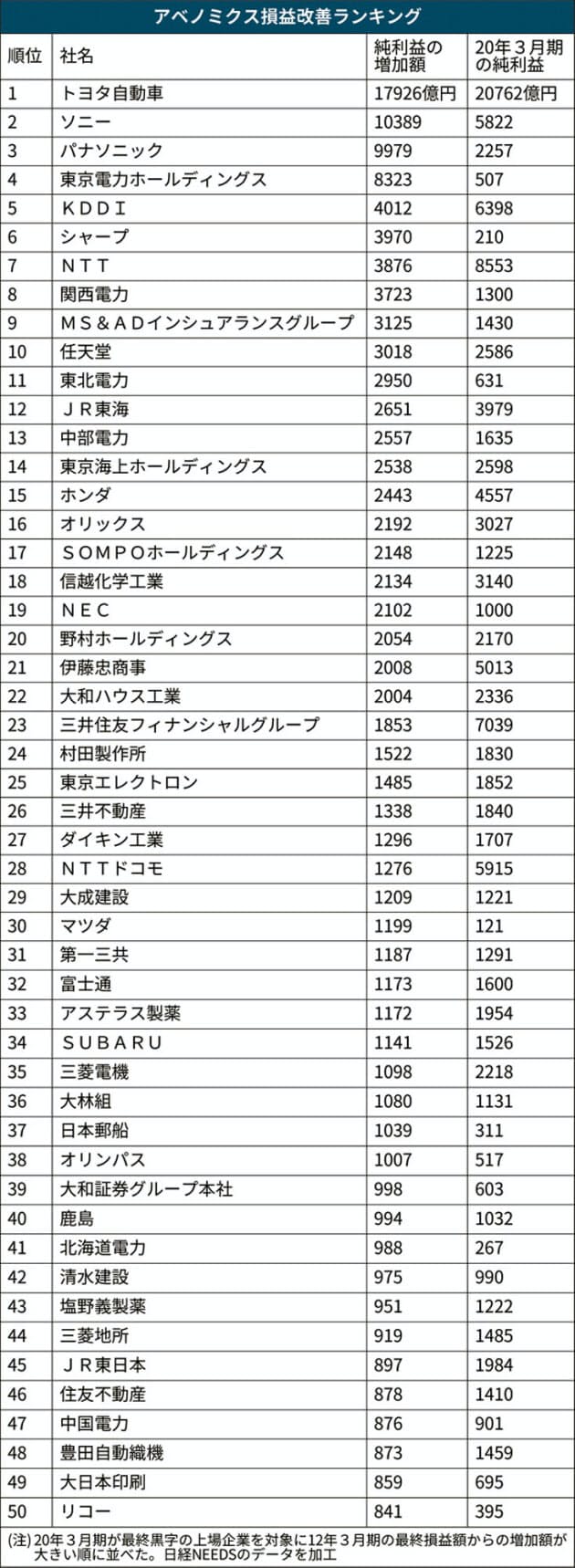 上場企業、アベノミクスで利益2倍 トヨタは1兆円超増
上場企業、アベノミクスで利益2倍 トヨタは1兆円超増
Abenomics makes double profits on listed companies, Toyota increases over 1 trillion yen
Companies that received the tailwind of the depreciation of the yen strove to reduce costs, and at one point recorded the highest profits. Under Abenomics, which lasted nearly eight years, the performance of listed companies has improved significantly. Net income for the fiscal year ended March 2020 was 23 trillion yen, 2.1 times higher than that for the fiscal year ended March 2012.
The impact of the Great East Japan Earthquake that occurred in 2011 was large in the fiscal year ended March 2012, but when ranking the amount of improvement in final profit and loss in the fiscal year ended March 2008 compared to this period, Toyota Motor Co. , Ltd. ranked first with net income of 1,07926. It increased by 100 million yen. Sony, which is in second place, also improved its final profit and loss by more than 1 trillion yen. The higher-level Panasonic , Sharp , Honda is external demand companies such as conspicuous. Some electric power companies have stopped nuclear power plants one after another after the earthquake.
The tailwinds were the extra-dimensional monetary easing promoted by the Abe administration and the creation of fiscal demand such as the national resilience policy. The effect of monetary easing was particularly large, and the yen appreciated to the 70 yen level per dollar in 2012, but the yen depreciated to just over 125 yen in 2015. This led to an increase in the profitability of export companies and an increase in sales of affiliated companies due to an increase in visitors to Japan.
Toyota's yen depreciation against the dollar boosts operating income by 40 billion yen. The depreciation of the yen was the biggest boost to operating income between the 355.6 billion yen in the fiscal year ended March 2012 and the highest profit of 2,853.9 billion yen in the fiscal year ended March 2016. The effect of the profit increase was 1,490 billion yen, which exceeded the cost reduction (1.41 trillion yen) and the sales increase (640 billion yen). Pushed by Abenomics, companies strove to cut costs. Since he suffered from prolonged deflation and the earthquake, he reduced fixed costs by curbing labor costs and capital investment. We lowered the "break-even point" where sales and expenses are at exactly the same level, making it difficult for sales to fall into the red.
According to Nikkei's estimate using a regression analysis model, the break-even ratio of listed companies declined from 85% in the fiscal year ended March 31, 2012 to 73% in the fiscal year ended March 31, 2006. Increased sales by 26% while reducing fixed costs by 2%. The ratio of variable expenses to sales rose by 3 percentage points to 69%, but was absorbed. The effect of lowering the break-even point by reducing fixed costs is large.
Sony has accelerated structural reforms in its electronics business since around 2012. Reduced fixed costs of the TV business, which had been in the red for 10 consecutive years, by more than 60%. The personal computer business was sold. The number of consolidated employees at the end of March this year was 111,700, a decrease of 30% compared to the end of March 2012.
Source: https://www.nikkei.com/article/DGXMZO63558480Y0A900C2DTA000/
 English
English Japan
Japan
